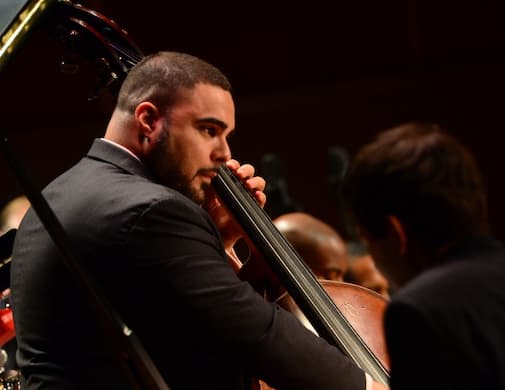Get Up and Dance as You Stream the Music of Thelonious Monk
With the bassist Carlos Henriquez serving as musical director, the Jazz at Lincoln Center Orchestra offers 10 Monk tunes — both famous and relatively obscure — in the Afro-Latin style.

‘Monk con Clave‘
The Jazz at Lincoln Center Orchestra
Musical Director: Carlos Henriquez
Available until May 28 at https://2022.jazz.org/monk-con-clave
The music of Thelonious Monk (1917-82) is all about rhythm. Sure, there’s his distinctively spikey, chromatic harmony, his memorable melodies, and his belly-laugh sense of humor — all of which are enhanced by his masterful timing and judicious sense of space, or what critic Kevin Whitehead once accurately described as his use of “trapdoor silences.” Yet rhythm is the point: Most of the time it’s so paramount in Monk’s compositions that the rhythm and the melody are almost the same thing.
This makes it surprising that virtually no one ever dances to Monk’s music — one memorable exception being a 2005 Jazz at Lincoln Center concert in which contemporary tap star Savion Glover performed “Jazz in Motion — Tapping into Monk.” The most notable individual to dance to Monk’s music was the composer himself, who frequently arose from his piano bench while the other members of his quartet were soloing and pirouetted dancing-bear-like around the stage.
Thus, this weekend’s “Monk con Clave” concert had to be the most danceable presentation of the Thelonious oeuvre that I’ve heard. As is the custom at Jazz at Lincoln Center, one member of the orchestra, in this case bassist Carlos Henriquez, served as musical director. He orchestrated 10 Monk tunes — both famous and relatively obscure — in the Afro-Latin style. Mr. Henriquez also complemented the regular orchestra with five specialty players: trumpeter Michael Rodriguez, tenor saxophonist Abdias Armenteros, pianist Osmany Parades, and two percussionist-vocalists, Pedrito Martinez and Anthony Almonte.
Monk’s music was almost always played by small groups that centered on the composer’s piano, and so the first surprise — even though the Jazz at Lincoln Center Orchestra has played Monk before — is hearing his melodies exploding in the colors of seven brass and five reeds.
Mr. Henriquez, whose compositional and arranging skills are also showcased in an excellent new album dedicated to the neighborhood of his birth, “The South Bronx Story,” knows well the infinite variety of both Afro-Latin jazz styles and the different approaches to Monk’s music that they represent. “Who Knows,” an infrequently performed Monk work from 1947, was orchestrated, as Mr. Henriquez explained, in the classic tradition of el Rey del Mambo, Tito Puente. The 1967 “Teo,” however, suggested the more expansive Latin-jazz style of Chico O’Farrill, and featured new lyrics by Mr. Henriquez chanted en Espanol by Mr. Almonte.
Sometimes the familiar tune was front and center, as on the opener, “I Mean You”; at other times, you had to listen hard to hear it, as on the closer, “Blue Monk.”
One particularly positive aspect was that the Latin approach concentrated attention on aspects of the JALCO that normally don’t get enough attention. As is the tradition in Salsa jazz, the baritone saxophone is the linchpin of the horns, which was great for those of us who always want to hear more of the JALCO’s Paul Nedzilla, credibly filling the big shoes of the late Joe Temperley.
Three highlights originated on Monk’s classic 1968 album “Underground.” “Raise Four,” a deceptively simple blues, climaxed in an exciting passage where all three percussionists — the two guests plus trap drummer Obed Calviere — played against other, which led to an even more exciting tutti when the rest of the orchestra, led by tenor saxophonist Victor Goines, jumped back in. “Green Chimneys,” one of the most-performed of Monk’s later works, brought out the pop-jazz side of the orchestra, evoking Quincy Jones and Henry Mancini, with Ted Nash playing the memorable melody on piccolo.
“Ugly Beauty” is not only one of Monk’s most lyrical tunes, it’s his only waltz — though in Latinizing it, Mr. Henriquez added an extra beat and rendered it in 4/4. Later that night at Dizzy’s, when vibraphonist Joel Ross led a small group billed as “Young Monk Project” that also played “Ugly Beauty,” he restored it to 3/4 in a warmly expressive treatment, proving that it works both ways.
“Monk con Clave” was a fast-moving concert that didn’t wear out its welcome, and also included a mash-up of two Monk classics called “Evidence of Four In One” constructed by Mr. Henriquez’s frequent collaborator Danilo Perez for his 1996 album “Panamonk.” And there was an original, “San Juan Hill,” named for the long-gone Hispanic-African American neighborhood where Monk lived and where the main campus of Lincoln Center now sits. The evening was 90 minutes of solid music with no intermission and no downtime.
As if to prove my point about Monk being more danceable con clave, in the last number, a couple got up and started mambo-ing in the aisles. I swear that the tall guy in a fedora and bow tie wasn’t me.

